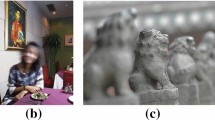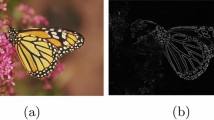Abstract
Image acquisition processes usually add some level of noise and degradation, thus causing common problems in image restoration. The restoration process depends on the knowledge about the degradation parameters, which is critical for the image deblurring step. In order to deal with this issue, several approaches have been used in the literature, as well as techniques based on machine learning. In this paper, we presented an approach to identify blur parameters in images using the Optimum-Path Forest (OPF) classifier. Experiments demonstrated the efficiency and effectiveness of OPF when compared against some state-of-the-art pattern recognition techniques for blur parameter identification purpose, such as Support Vector Machines, Bayesian classifier and the k-nearest neighbors.
Access this chapter
Tax calculation will be finalised at checkout
Purchases are for personal use only
Similar content being viewed by others
Notes
- 1.
All these ranges for both L and \(\sigma \) were empirically chosen.
- 2.
The experiments were conducted on a computer with a Pentium Intel Core i5® 650 3.2 Ghz processor, 4 GB of memory RAM and Linux Ubuntu Desktop LTS 12.04 as the operational system.
References
Mammone, R.J.: Computational Methods of Signal Recovery and Recognition. Wiley, New York (1992)
Shacham, O., Haik, O., Yitzhaky, Y.: Blind restoration of atmospherically degraded images by automatic best step-edge detection. Pattern Recogn. Lett. 28(15), 2094–2103 (2007)
Papa, J.P., Fonseca, L.M.G., de Carvalho, L.A.S.: Projections onto convex sets through particle swarm optimization and its application for remote sensing image restoration. Pattern Recogn. Lett. 31(13), 1876–1886 (2010)
Pires, R.G., Pereira, D.R., Pereira, L.A.M., Mansano, A.F., Papa, J.P.: Projections onto convex sets parameter estimation through harmony search and its application for image restoration. Nat. Comput. 15(3), 493–502 (2016)
Papa, J.P., Mascarenhas, N.D.A., Fonseca, L.M.G., Bensebaa, K.: Convex restriction sets for cbers-2 satellite image restoration. Int. J. Remote Sens. 29(2), 443–458 (2008)
Katsaggelos, A.K.: Digital Image Restoration. Springer-Verlag New York, Inc., Secaucus (1991)
Zhou, Y.-T., Chellappa, R., Vaid, A., Jenkins, B.K.: Image restoration using a neural network. IEEE Trans. Acoust. Speech Sig. Process. 36(7), 1141–1151 (1988)
Paik, J.K., Katsaggelos, A.K.: Image restoration using a modified hopfield network. IEEE Trans. Image Process. 1, 49–63 (1992)
Sun, Y., Yu, S.Y.: A modified hopfield neural network used in bilevel image restoration and reconstruction. In: International Symposium on Information Theory Application, vol. 3, pp. 1412–1414 (1992)
Qiao, J., Liu, J.: A SVM-based blur identification algorithm for image restoration and resolution enhancement. In: Gabrys, B., Howlett, R.J., Jain, L.C. (eds.) KES 2006. LNCS, vol. 4252, pp. 28–35. Springer, Heidelberg (2006). doi:10.1007/11893004_4
Li, D.: Support vector regression based image denoising. Image. Vis. Comput. 27(6), 623–627 (2009)
Xia, Y., Sun, C., Zheng, W.X.: Discrete-time neural network for fast solving large linear l1 estimation problems and its application to image restoration. IEEE Trans. Neural Netw. Learn. Syst. 23(5), 812–820 (2012)
Tang, Y., Salakhutdinov, R., Hinton, G.: Robust boltzmann machines for recognition and denoising. In: IEEE Conference on Computer Vision and Pattern Recognition, 2012, Providence, Rhode Island, USA (2012)
Zhang, G.-D., Yang, X.-H., Xu, H., Lu, D.-Q., Liu, Y.-X.: Image denoising based on support vector machine. In: 2012 Spring Congress on Sarvajanik College of Engineering & Technology, pp. 1–4. IEEE (2012)
Li, D., Mersereau, R.M., Simske, S.: Blind image deconvolution through support vector regression. IEEE Trans. Neural Netw. 18(3), 931–935 (2007)
Papa, J.P., Falcão, A.X.: A new variant of the optimum-path forest classifier. Int. Symp. Vis. Comput. 47(1), 935–944 (2008)
Papa, J.P., Falcão, A.X., Suzuki, C.T.N.: Supervised pattern classification based on optimum-path forest. Int. J. Imaging Syst. Technol. 19(2), 120–131 (2009)
Papa, J.P., Falcão, A.X., Albuquerque, V.H.C., Tavares, J.M.R.S.: Efficient supervised optimum-path forest classification for large datasets. Pattern Recogn. 45(1), 512–520 (2012)
Papa, J.P., Fernandes, S.E.N., Falcão, A.X.: Optimum-path forest based on k-connectivity: theory and applications. Pattern Recogn. Lett. 87, 117–126 (2017). Advances in Graph-based Pattern Recognition
Allène, C., Audibert, J.-Y., Couprie, M., Keriven, R.: Some links between extremum spanning forests, watersheds and min-cuts. Image Vis. Comput. 28(10), 1460–1471 (2010)
Dash, R., Sa, P.K., Majhi, B.: Blur parameter identification using support vector machine. In: Proceedings of the International Conference on Advances in Computer Science, pp. 89–92 (2011)
Wilcoxon, F.: Individual comparisons by ranking methods. Biom. Bull. 1(6), 80–83 (1945)
Nemenyi, P.: Distribution-free Multiple Comparisons. Princeton University (1963)
Demšar, J.: Statistical comparisons of classifiers over multiple data sets. J. Mach. Learn. Res. 7, 1–30 (2006)
Acknowledgment
The authors are grateful to FAPESP grants #2014/16250-9 and #2014/12236-1, CNPq grant #306166/2014-3, as well as CAPES.
Author information
Authors and Affiliations
Corresponding author
Editor information
Editors and Affiliations
Rights and permissions
Copyright information
© 2017 Springer International Publishing AG
About this paper
Cite this paper
Pires, R.G., Fernandes, S.E.N., Papa, J.P. (2017). Blur Parameter Identification Through Optimum-Path Forest. In: Felsberg, M., Heyden, A., Krüger, N. (eds) Computer Analysis of Images and Patterns. CAIP 2017. Lecture Notes in Computer Science(), vol 10425. Springer, Cham. https://doi.org/10.1007/978-3-319-64698-5_20
Download citation
DOI: https://doi.org/10.1007/978-3-319-64698-5_20
Published:
Publisher Name: Springer, Cham
Print ISBN: 978-3-319-64697-8
Online ISBN: 978-3-319-64698-5
eBook Packages: Computer ScienceComputer Science (R0)




